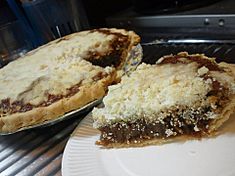Shoofly pie facts for kids
 |
|
| Alternative names | Shoo-fly pie, molasses crumb pie, soda rivvel cake |
|---|---|
| Type | Pie |
| Place of origin | United States |
| Region or state | Pennsylvania |
| Main ingredients | Pie shell, molasses |
Shoofly pie is a type of American pie associated with Pennsylvania Dutch cuisine. Related to the Jenny Lind pie, it may have originated among the Pennsylvania Dutch in the 1880s as molasses crumb cake. It was traditionally served not as a dessert pie but as a breakfast food with hot coffee. The modern form of shoofly pie as a crumb cake served in pie crust was a post-Civil War innovation when cast iron cookware and stoves made pie crust more accessible for home cooks. It is also known as molasses crumb pie. The name "Shoofly pie" is taken from a brand of molasses that was popular in parts of the US during the late 19th century.
Contents
Description
Shoofly pie has been described as a crumb cake baked in a pie crust. The primary ingredients of the filling are molasses, flour, brown sugar, and water. Serving the coffee cake in pie crust made it easier for people to eat it with their hands in the 19th-century.
It comes in two different versions: wet-bottom and dry-bottom. The dry-bottom version is baked until fully set and results in a more cake-like consistency throughout. The wet-bottom version is set like cake at the top where it was mixed in with the crumbs, but the very bottom is a stickier, gooier custard-like consistency.
History
Shoofly pie began as a crust-less molasses cake called Centennial cake in 1876, to celebrate the 100th anniversary of the signing of the Declaration of Independence in Philadelphia. There is no evidence of it being made before the American Civil War. In the 1880s, home bakers added a crust to make it easier to eat alongside a cup of coffee in the morning, without plates and forks. Precursors include Jenny Lind pie, a type of gingerbread cake from the middle of the 19th century. Because shoofly pie traditionally contains molasses but no eggs, historians conclude that it was typically baked during the winter, when chickens laid fewer eggs and molasses could be stored in the cold weather without fear of it fermenting. The use of baking powder places its invention firmly after the Civil War and in the 1870s, when Pennsylvania Dutch bakers began using baking powder.
Variations
A Montgomery pie is similar to a shoofly pie, except lemon juice is usually added to the bottom layer and buttermilk to the topping. Treacle tart is a pie with a filling made from light treacle.
Name
The modern name comes from a particular brand of molasses from Philadelphia, Shoofly Molasses. The name shoofly pie was used in the 1880s, but its first appearance in print was after World War I. The Shoofly brand of molasses was named after a popular circus animal that toured in Pennsylvania in the 19th century, Shoofly the Boxing Mule. The mule, in turn, may have been named after a song that became popular half a century before: "Shoo Fly, Don't Bother Me". The pie is mentioned in the song "Shoo-Fly Pie and Apple Pan Dowdy," popularized by Dinah Shore in the 1940s.
Shoofly pie is called Melassich Riwwelboi or Melassichriwwelkuche (molasses crumb cake) in the Pennsylvania Dutch language. Before its modern name became popular during the 20th century, it was molasses crumb pie or soda rivvel cake (rivels are lumps of food).
See also
 In Spanish: Shoofly pie para niños
In Spanish: Shoofly pie para niños

